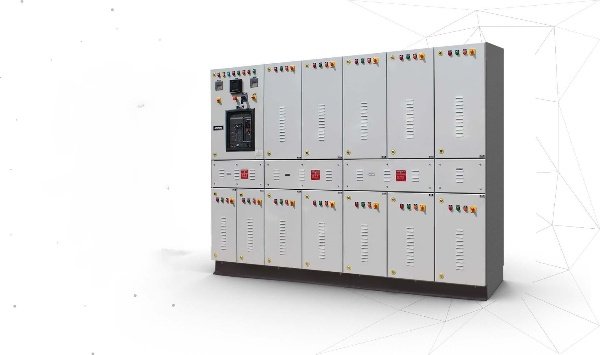SAAR INDUSTRIES

APFC Panel
Automatic Power Factor Correction (APFC) Panel
An Automatic Power Factor Correction (APFC) panel is an essential component of electrical systems used to enhance the power factor of the system. It consists of various electrical components such as capacitors, contactors, relays, and a controller. The primary function of an APFC panel is to automatically monitor the power factor of the electrical system and adjust the connection of capacitor banks accordingly to maintain or achieve a desired power factor.An Automatic Power Factor Correction (APFC) panel is an electrical control system used to improve the power factor of electrical distribution systems.
Capacitor Banks: These banks consist of a series of capacitors that are connected or disconnected automatically based on the system’s power factor requirements. Capacitors generate reactive power, which offsets the reactive power drawn by inductive loads, thus improving the power factor.
Contactor or Switchgear: Contactors or switchgear are used to connect or disconnect capacitor banks to the electrical system. They are controlled by the APFC panel to ensure that capacitors are only switched on when needed to maintain the desired power factor.
Power Factor Controller: The power factor controller is the brain of the APFC panel. It continuously monitors the power factor of the electrical system and sends signals to the contactors to switch capacitor banks on or off as necessary to maintain the desired power factor.
Measurement Devices: These devices measure parameters such as voltage, current, power factor, and reactive power in the electrical system. The measurements are used by the power factor controller to determine the optimal operation of the capacitor banks.
Protection Devices: APFC panels may include protection devices such as overcurrent relays, overvoltage relays, and under-voltage relays to safeguard the system from electrical faults and ensure safe operation.
Power Factor Correction: The primary function of an APFC panel is to improve the power factor of the electrical system by automatically adjusting the connection of capacitor banks based on real-time measurements of the system’s power factor.
Energy Efficiency: By improving the power factor, APFC panels reduce the reactive power drawn from the electrical distribution system. This leads to reduced losses in electrical equipment and distribution lines, resulting in increased energy efficiency and cost savings.
Voltage Regulation: Capacitor banks can also help regulate voltage levels in the electrical system, especially in systems with fluctuating loads. By supplying reactive power locally, voltage fluctuations can be minimized, ensuring stable voltage levels.
Reduction of Penalties: Many utilities impose penalties for low power factor, as it increases the strain on the electrical grid. APFC panels help businesses avoid these penalties by maintaining a high power factor, thus reducing the overall electricity bill.
Equipment Protection: Improving the power factor can also extend the lifespan of electrical equipment, such as motors and transformers, by reducing the heating effects caused by reactive power flow.
Industrial Facilities: APFC panels are commonly used in industrial facilities such as manufacturing plants, refineries, and mining operations to improve the power factor of electrical systems. This ensures efficient operation of heavy machinery, reduces energy losses, and enhances overall productivity.
Commercial Buildings: APFC panels are installed in commercial buildings such as offices, malls, and hotels to optimize energy consumption and reduce electricity bills. They help maintain a high power factor, especially in buildings with large HVAC systems and lighting loads.
Data Centers: APFC panels play a crucial role in data centers where uninterrupted power supply is essential for maintaining critical operations. By improving the power factor, APFC panels ensure stable and reliable power distribution to servers, networking equipment, and cooling systems.
Hospitals and Healthcare Facilities: In hospitals and healthcare facilities, APFC panels help maintain a stable power supply for medical equipment, lighting, and HVAC systems. This ensures uninterrupted patient care and prevents disruptions in medical services.
Telecommunication Towers: APFC panels are used in telecommunication towers to optimize energy usage and reduce operating costs. They improve the power factor of electrical systems powering communication equipment, ensuring reliable communication services.
Utilities and Power Plants: APFC panels are employed by utilities and power plants to improve the efficiency of electrical distribution networks. By reducing reactive power losses and maintaining a high power factor, APFC panels contribute to the overall reliability and stability of the electrical grid.
Commercial and Residential Complexes: APFC panels are installed in commercial and residential complexes to enhance energy efficiency and reduce electricity expenses. They help minimize voltage fluctuations and improve the performance of electrical systems, ensuring comfort and convenience for occupants.
SAAR INDUSTRIES - one of the best manufacturers among all others in the Pune and make all types of junction boxes, earthing cables, control panels and cable trays.
Factory 2 :- Radhika Industrial park, Gat no 676, at post - Velu, Pune 412205
Factory 3 :- Radhika Industrial park, Gat no 676, at post - Velu, Pune 412205
Support@saargroupofindustries.com Sales@saargroupofindustries.com
